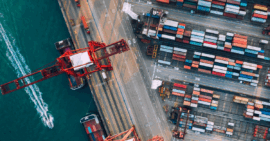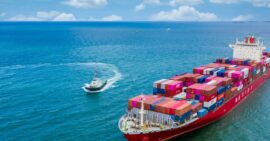As global trade undergoes a significant transformation, Diana Caceres, Senior Tax Research Manager at Thomson Reuters, speaks to Kunio Mikuriya, Secretary General of the World Customs Organization, about the key challenges that companies face in the international trade environment today. We also discuss the role of customs in supporting cross-border business, future outlook, and how modern technology can optimize trade flows.
What are the biggest challenges Customs authorities face from Covid-19?
Kunio Mikuriya: Customs administrations, like many essential government services, have continued to operate throughout this challenging situation to ensure the smooth supply of goods (including key medical equipment), and prevent attempts by smugglers and criminals to bring in illicit and sometimes dangerous goods.
Administrations have had to take steps to protect their staff, and ensure supply chain and business continuity, whilst putting in place extra precautions to prevent the spread of the virus. By using online platforms to manage client queries, and exploiting digital processes through internet-based Customs management systems, Customs have managed to maintain some form of normality and deploy staff from home.
The COVID-19 pandemic has shown the importance of major concepts which we have been promoting for years: an all-digital and paperless clearance process, and efficient risk management through the collection and analysis of quality data. It has also highlighted the need for Customs administrations and trade and logistics operators to engage with each other in order to obtain a clear view of the challenges faced by all sides. This line of communication will enable Customs to develop policies and processes that are fit for purpose, take adequate provisional measures to support businesses, communicate any decisions and changes rapidly and efficiently ensure compliance.
It will be interesting to monitor whether the crisis leads to some form of restructuring, i.e. whether apparel, electronics and pharmaceutical companies rethink their supply chains so that they are globally diversified and less dependent on one or two locations. In fact, changing suppliers and logistics providers, as well as revising sourcing, will become more prevalent as companies seek to better secure their supply chains. Customs may have an educational and enforcement role to play here, to provide a business-friendly environment while at the same time ensuring that these changes do not inadvertently cause compliance issues, such as violations of Customs regulations, sanctions, export controls, or other trade laws.

How can Customs administrations provide clearer information on the documentation needed for imports/exports?
Kunio Mikuriya: It is essential that information on cross-border procedures be clear and easily accessible to all interested parties. Lack of transparency has been identified as the first “chokepoint” in the supply chain.
The need for transparency is actually embedded in several international instruments adopted by the WCO and the World Trade Organization (WTO). These include Chapter 9 of the WCO Revised Kyoto Convention (“Information, Decisions and Rulings supplied by the Customs”), the WCO Recommendation on the Use of World Wide Web sites by Customs administrations, Article X of the General Agreement on Tariffs and Trade (“Publication and Administration of Trade Regulations”), and Articles 1, 2 and 3 of the WTO Trade Facilitation Agreement (“Publication and availability of information”, “Opportunity to comment, information before entry into force, and consultations”, and “Advance rulings”, respectively). All existing provisions are explained and compiled in the WCO Transparency and Predictability Guidelines.
The requirement to publish information is not limited to Customs administrations, as it also extends to other government bodies. However, many operators may face difficulties in differentiating between the jurisdiction of Customs administrations and that of other border agencies. Customs websites should therefore provide users with the necessary trade-related information which is managed by other governmental agencies or with the necessary contact information.
Many countries have developed portals where all the trade-related information is accessible, yet the question of how to communicate more effectively still remains unanswered. That is why Customs administrations need to look beyond simply providing information and consider ways of ensuring that they communicate and engage with stakeholders.
There are various levels of communication. A first level might be the provision of information upon request, via call centres or websites and different media channels. A second level would be to consult stakeholders on specific, clearly defined issues through the use of forums and committees.
A third – and more advanced – level of communication is to give stakeholders the opportunity to engage with public officials in co-creating policies. This last level illustrates the idea that communication can be used strategically to develop policies.
Communication is often limited to promoting the government’s image or disseminating news, and does not necessarily always contribute to transparency and stakeholders’ participation. There needs to be a culture shift to change this approach.
What will be the main changes in relation to the new HS codes for 2022? How can companies prepare for these changes?
Kunio Mikuriya: The main purpose of the HS 2022 amendments is adapting to current trade through the recognition of new product streams, and by addressing environmental and social issues of global concern.
One example of a product class which presents significant policy concerns, as well as a high value of trade, is electrical and electronic waste (commonly referred to as e-waste). HS 2022 includes specific provisions for its classification to assist countries in their work under the Basel Convention.
There will also be new provisions on novel tobacco and nicotine-based products, reflecting the difficulties in their classification, the lack of visibility in trade statistics and the very high monetary value of this trade.
Unmanned aerial vehicles (UAVs), commonly referred to as drones, will also gain their own specific provisions, simplifying the classification of these aircraft. So too, HS 2022 will give smartphones their own subheading and Note, thus providing greater clarity.
An area of focus for the future is the classification of multi-purpose intermediate assemblies as the trade in such products has increased significantly. However, HS 2022 already addresses one such product: flat panel display modules, which will be classified as products in their own right, simplifying classification of these modules by removing the need to identify their final use.
Health and safety also feature in the changes. In recognition of the dangers of delays in deploying tools to rapidly diagnose infectious diseases in outbreaks, changes have been made to the provisions for diagnostic kits, thus simplifying classification. The previous absence of a specific classification code for such products caused problems when responding to the urgent need for facilitating the clearance of medical goods during the COVID-19 health crisis. In addition, new provisions for placebos and clinical trial kits for medical research will make classification possible without information on the placebo ingredients. This will help facilitate cross-border medical research. Cell cultures and cell therapy are among the product classes that have gained new and specific provisions.
Given the breadth and importance of the changes, I would invite you to visit our website, where you will find a list of all the amendments.
HS 2022 will come into force on 1 January 2022. While this date may seem far off, Customs administrations and regional economic communities should be taking steps now to prepare for its implementation. Indeed, they already need to start amending their national Customs tariff or statistical nomenclatures, with a view to publishing them so that trade operators can update their systems. National tariff schedules must be ready in advance, as traders need adequate time to convert existing databases. Correlation tables between the latest and the new edition of the HS should be provided to trade stakeholders so that they can easily assess the impact of the changes on their business. These efforts by both the public and private sectors should enhance transparency and predictability while preventing any confusion when the changes come into practice.
Another key piece of information that Customs can give traders relates to advance ruling. This is a vital facilitation tool and I would encourage importers to use it when available if they need to know how goods are to be classified.
As a matter of fact, companies and industry organizations should be able to contact their home Customs administration directly on the subject of classification. It is with this in mind that a list of HS officials in national administrations can be found on the WCO website. Indeed, at the WCO, we rely on this participation at national level to enable us to make classification decisions on complex commodities and keep the HS up-to-date. In this way, the HS can reflect technological developments and changes in trade flows.
What is the role of technology in ensuring the smooth flow of global trade?
Kunio Mikuriya: Customs’ mandate is to ensure that goods flowing across borders comply with a wide range of regulatory requirements and multilateral trading rules. To fulfil that mandate efficiently, Customs make use of technology in implementing effective controls, and in facilitating, enhancing and accelerating processes for the benefit of governments, traders and citizens.
Technology includes both physical equipment, such as scanners/Non-Intrusive Inspection (NII) systems, and technological tools that derive their primary value from data. With the convergence of technology, the distinction between the two is now becoming increasingly blurred.
It is essential for Customs to leverage technology; however, we should bear in mind that technology is only an enabler and that Customs administrations also need to transform their processes.
Examples of technology as an enabler are legion among our Members. Technology has supported Customs in enhancing connectivity, both at national and international levels. At national level, it has led to the creation of a “Single Window” environment where many services can work in a collaborative and coordinated manner. The concept of connectivity is not new and we have been promoting it for years. However, with technological advancements, we are closer to our ultimate objective of creating an environment where government agencies and the private sector operate effectively and share high-quality, reliable data across borders and jurisdictions, thus speeding up and improving processing times.
The role of the WCO is to help Customs administrations in this endeavour by developing standards, steering discussions on the future of Customs, providing forums where experiences and achievements can be shared, and organizing events where technology providers and Customs representatives can meet.
The WCO has developed standards in support of IT tools. Examples include the WCO Data Model for the harmonization of electronic data requirements, the Unified X-ray File Format (UFF) for the harmonization of data generated by non-intrusive inspection devices, and standards for the electronic exchange of passenger-related information.
The WCO has also produced substantial guidance on the implementation of technologies. This includes the ICT Guidelines to help administrations implement the Standards and Recommended Practices contained in the Revised Kyoto Convention, the Single Window Guidelines, and the recently updated Guidelines for the Procurement and Deployment of Scanning/NII Equipment.
Nowadays, discussions are focused on the introduction and expanded use of disruptive technologies such as blockchain, which can provide secure access to digital transaction records (thus improving compliance and enhancing trade facilitation) while reducing transaction costs and verification times for the trading community. Machine learning also offers a host of opportunities, and is an area in which we are closely following developments.



